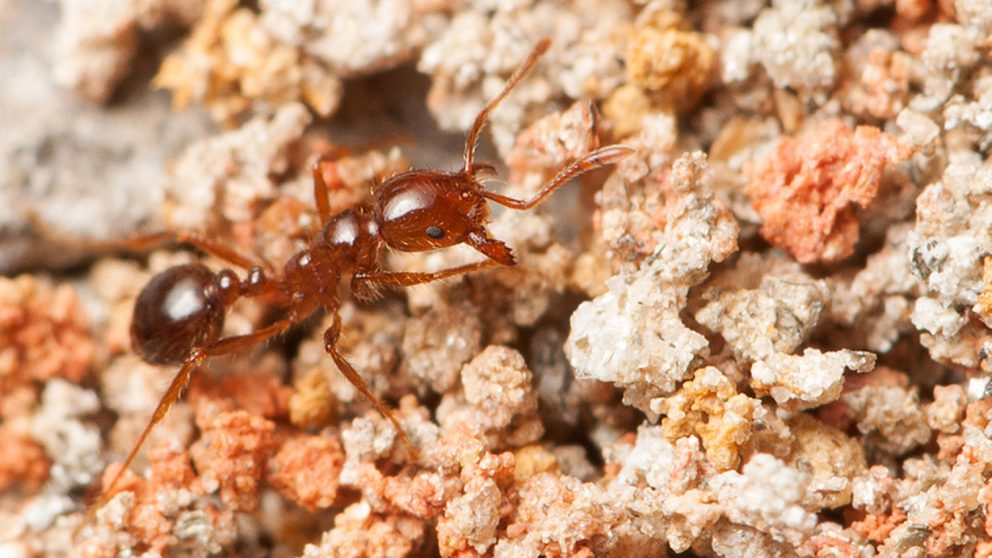The Benefits for Invertebrates of Leaving Behind Biomass Harvest Residues

This is a summary of research by Global Change Fellows Steven Grodsky (2012-14) and Sarah Fritts (2011-13), along with Faculty Affiliate Chris Moorman, NC State Department of Forestry and Environmental Resources, and other researchers. Authored by D’Lyn Ford of NC State, it appeared on the NCSU News Website. You can view the original post here.
Intensive Biomass Harvest Linked to Fire Ant Colonization, Declines in Some Invertebrates
Removing almost all of the woody debris on the ground after timber cutting can open the door to red imported fire ant colonization, according to in-depth studies in managed forests in North Carolina and Georgia.
Researchers with North Carolina State University examined ant communities in harvested pine stands with varying levels of downed wood removal, from zero to intensive harvesting. A growing market for wood pellets as a form of renewable energy gives an incentive to consider removing the less valuable tree stems typically left on the ground after harvest, which can be used as a source of woody biomass for pellets.
“What we found is that if there’s intensive removal of harvest residues to the point where there’s little coarse woody debris left on the ground, it’s linked to an increase in red imported fire ant colonization and a decrease in overall invertebrate diversity,” says former NC State doctoral graduate Steven Grodsky, lead author of related articles on the research in Ecological Applicationsand Forest Ecology and Management.
As an invasive species, fire ants readily move into disturbed areas, including recently harvested pine plantations, Grodsky says. Because fire ants nest in bare ground, removing almost all of the woody debris creates even more inviting spaces for the invaders to build their characteristic mounds and out-compete native ant species, which play important ecological roles, such as dispersing seeds.
“Fire ants pose a human health risk and have deleterious effects on other animals, so colonization is an issue for people and wildlife, as well as for land managers,” says Grodsky, now co-director of the Wild Energy Initiative and an energy-ecology postdoctoral scholar at the University of California, Davis.
Sites with more woody debris on the ground favored another invasive species, the Asian needle ant, previously associated with mature forests rather than regenerating pine forests. The Asian needle ant nests in woody debris – keeping it out of direct competition for resources with the red imported fire ant.
Invasive ants—primarily red imported fire ants—dominated overall ant populations, accounting for 94 percent of the ants that researchers captured in pitfall traps, even though invasive ants made up only 19 percent of the ant groups identified in the study.
“The key word is ‘intensive’ removal of downed wood,” Grodsky says. “If you leave some harvest residues behind, you’re not going to facilitate increased fire ant abundance. But if you take as much out as you possibly can, fire ants are going to be more abundant than they would have been otherwise.”
Ants and other invertebrates require woody debris for shelter, food and reproduction. To find out how differing levels of downed wood removal affected invertebrates, NC State researchers trapped and examined 40,000 surface-active invertebrates in harvested pine plantations for a second study, published in Ecological Applications.
Removing more than 85 percent of commercial woody biomass reduced the numbers and variety of invertebrate species in regenerating pine stands in North Carolina and Georgia, says co-author Chris Moorman, an NC State professor and coordinator of the Fisheries, Wildlife and Conservation Biology Program in the university’s College of Natural Resources.
“In previous research with other wildlife such as birds, mice and toads, we didn’t see these effects on a larger scale, but for invertebrates we did see lower numbers of cave crickets, fungus gnats, millipedes and wood roaches,” Moorman says. “Invertebrates are small creatures, but they play important roles in the ecosystem, including breaking down decaying plant material, distributing seeds and serving as food for other animals.”
In North Carolina, ground beetles and crickets were three times more plentiful at sites where no downed wood was removed than at those with the most intensive removal following timber harvesting, Moorman says. However, most invertebrates were unaffected by the removal of woody biomass.
Both studies highlight the need for landowners and forest managers to be aware of potential long-term effects of intensive woody biomass removal, Grodsky says. “The research affirms a basic principle of conservation: Don’t take it all. Leave something behind, in this case, downed wood.”
In addition to Grodsky and Moorman, co-authors of the Ecological Applications cover article, “Invertebrate community response to coarse woody debris removal for bioenergy production from intensively managed forests,” are Sarah R. Fritts of Texas State University, Joshua W. Campbell of the University of Florida, Clyde E. Sorenson and Matthew A. Bertone of NC State University, Steven B. Castleberry of the University of Georgia, and T. Bently Wigley of the National Council for Air and Stream Improvement. Grodsky, Campbell, Fritts, Wigley and Moorman co-authored “Variable responses of non-native and native ants to coarse woody debris removal following forest bioenergy harvests,” published in Forest Ecology and Management.
- Categories:
